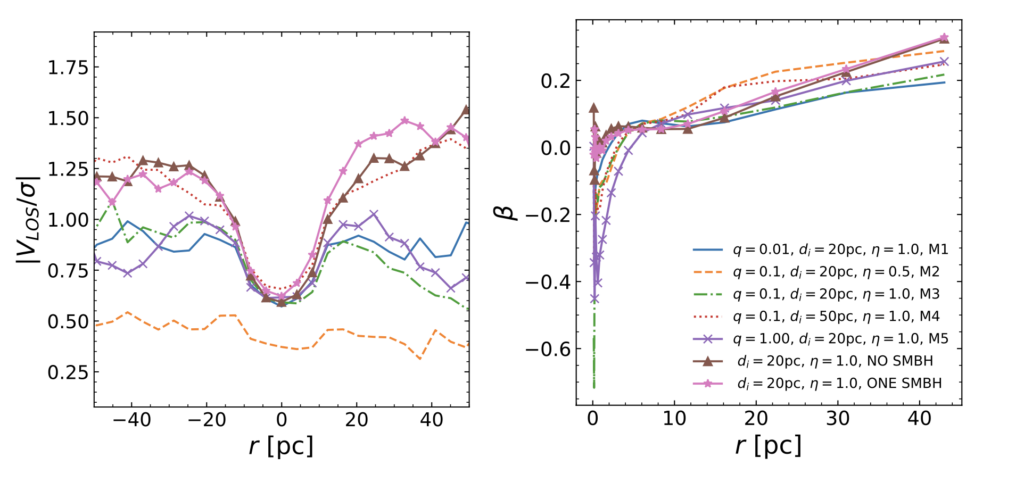Title: Searching for clues of past binary supermassive black hole mergers in nuclear star clusters
Authors: Alessandra Mastrobuono-Battisti, Go Ogiya, Oliver Hahn, Mathias Schultheis
First Author’s Institution: GEPI, Observatoire de Paris, PSL Research University
Status: Accepted for publication in MNRAS. Open access on the arXiv
Supermassive Black Holes (SMBH) are commonly seen at the centres of large galaxies with a stellar mass larger than times the mass of the Sun. Galaxies with a stellar mass between
solar masses have a dense and massive structure of stars gravitationally bound together called a Nuclear Star Cluster (NSC). Some observed galaxies, including our own Milky Way, have centres that host both SMBHs and NSCs.
A merger between galaxies with central SMBHs could produce a supermassive black hole binary (SMBHB). If the merging galaxies have an SMBH embedded in an NSC, the separation between the SMBHs decreases more efficiently, aiding in the quick formation of an SMBHB. Several other effects, like dynamical friction and stellar interactions, work together to reduce the separation between SMBHs. Such binaries will coalesce within the age of the universe (Hubble Time) and also emit gravitational waves while merging with each other. We should thus be able to see such SMBHBs at the centres of galaxies, right? Unfortunately, sky surveys have only identified a few binary SMBHB candidates. The lack of observational evidence for SMBHBs suggests that the binaries either merge very quickly or escape their galaxies.
Since it is difficult to directly detect the presence of an SMBHB at small spatial scales, we can look at the dynamical and structural signatures in the final NSC merger product. In today’s paper, the authors use simulations of NSC mergers to analyze the signatures left on the NSC environment by the merger event. These signatures could then be observed to aid direct SMBHB searches. The authors use five simulation runs of NSC mergers with an SMBH at the centre of each, a run with two SMBH-less NSCs, and one with only one of the merging NSCs hosting a central SMBH. Only the simulation with both NSCs hosting a central SMBH will produce an SMBH binary. We can therefore compare the results of the simulations to find indirect hints of an SMBHB.
Results of the simulation
The five runs without a central SMBH all have different initial conditions like the mass ratio between the two central SMBHs, the distance between the central nuclei and the initial angular momentum. The NSCs are modelled using an N-body code for effective collisional dynamics. The simulations are analysed for a total age of 20 Myr. The NSCs with central SMBHs will merge within 1-2 Myr, and at the end of the simulation time, there will be a binary that is significantly hardened (shrinking of the orbit). The authors observe that models with no or only one SMBH take more time to merge.
The shape of the final merged NSC hints at the presence of an SMBHB. The authors find that models with one or no SMBH appear more spherical in the centre than the simulations with two SMBHs. Imagine the NSC as an ellipsoid with a,b and c as the major, intermediate and minor axes. To quantify the NSC flattening, the authors analyze the axial ratios (b/a and c/a). Figure 1 shows the axial ratios for the progenitor NSCs and the final NSC for all seven simulations. The c/a ratios for ONE SMBH and NO SMBH cases are very high near the centre, which suggests the central spherical shape of these NSCs. The authors also notice that the final NSC’s density profile (density as a function of radial distance) depends strongly on the presence or the absence of an SMBH in the progenitors.

Another significant impact of the merger is seen in the kinematic structure of the merger product. To examine this, the authors use a parameter that evaluates the rotational support compared to the disordered motion in the cluster. Figure 2 plots this parameter as a function of the distance from the NSC centre, and the models with no or only one SMBH appear more rotationally supported than others. Figure 2 also shows a plot comparing the velocity anisotropy parameter β as a function of the radial distance. This parameter tells us the nature and shape of the NSC orbits. Figure 2 shows that all the β for NSCs with two SMBHS goes from a negative value near the central regions to a positive value at large distances. The models with no or one SMBH have almost zero anisotropy ( β ~0 ) at the centre and become positive as you move further away from the centre.

All the simulation cases explored shows us that an SMBH merger leaves strong signatures on the final NSC. Observations of the NSC’s chemical properties, shape and rotation kinematics can give us clues on the presence of an SMBH binary. Instruments like JWST (James Webb Space Telescope) and future facilities like HARMONI and MOSAIC at the ELT will provide us with more data on the shape and structure of many NSCs, helping us to “reveal” the presence of an SMBHB. This will also have huge implications for multi-messenger astronomy as the SMBHBs radiate gravitational waves that can be detected using LISA (Laser Interferometer Space Antenna) and IPTA (International Pulsar Timing Array).
Astrobite edited by Katherine Lee
Featured image credit: Adapted from NASA and Wikimedia Commons




